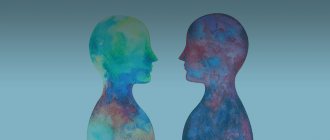Obsessive thoughts (obsessions) are images or impulses that invade consciousness uncontrollably, against a person’s will. Attempts to get rid of these thoughts lead to outbreaks of anxiety and bring severe discomfort. A person experiences constant fears and bad thoughts. If you do not seek help in time, obsessions lead to psychological exhaustion, social withdrawal and depression.
Obsessive thoughts occur in many diseases: neuroses, depression, obsessive-compulsive disorder (obsessive neurosis) and even schizophrenia.
Features that distinguish obsessive thoughts syndrome:
- a person cannot influence the appearance of such thoughts, thoughts arise against desire;
- obsessive thoughts are not connected with a person’s usual thoughts - they are separate, alien images;
- obsessive thoughts syndrome cannot be overcome by willpower;
- the disorder is associated with intense anxiety and irritability;
- clarity of consciousness and critical perception of one’s condition are usually preserved.
The disorder is extremely difficult to bear. Usually a person is aware of what obsessive thoughts mean, understands the irrationality of the images that arise in the head, but cannot fight them. Attempts to stop the appearance of thoughts and the coercive actions associated with them are unsuccessful and lead to even greater distress.
People who suffer from this disorder are not difficult to convince that their obsessive thoughts are unfounded. But this does not help get rid of the problem. Situations repeat themselves over and over again. A necessary step to getting rid of painful conditions is to seek help from a specialist before complications arise.
What are obsessive thoughts?
Obsessive thoughts torment a person, they are unpleasant and disturbing, you want to hide from them, run away. There are all kinds of obsessions.
Here are some examples of what intrusive thoughts can be:
- concerns about pollution and the spread of disease;
- pathological need for order and symmetry;
- obsessive and uncontrolled counting;
- obsessive thoughts about bad things: a person constantly thinks about accidents that could happen to him, to his loved ones, to his property, or even to humanity as a whole;
- groundless and unreasonable avoidance of certain actions or objects;
- thoughts of a religious, sexual, aggressive or any other nature that are alien to the patient’s thinking and arise against his will.
Constant intrusive thoughts cause unbearable discomfort. Of course, a person has a desire to succumb to these ideas and try to correct the situation. In this case, compulsions appear - actions that a person is forced to periodically perform, even if he does not want to, in order to control what is happening in his head. When intrusive thoughts (obsessions) and compulsive actions (compulsions) are present together, take a lot of time, interfere with life and cause suffering, this indicates the presence of a disease such as obsessive-compulsive disorder (OCD).
A person begins to avoid cracks in the asphalt or touch every tree on the road because alien thoughts “tell” him that if he does not do this, something bad will happen.
Usually compulsions force you to do something over and over again, like a ritual. By giving in to the compulsion, the person hopes that he can prevent or reduce the anxiety that accompanies the obsessions. For example, he begins to avoid cracks in the asphalt or touches every tree on the road because alien thoughts “tell” him that if he doesn’t do this, something bad will happen. Unfortunately, such actions do not bring relief and only get worse over time, taking the form of an endless ritual.
In addition to OCD, there are other diseases in psychiatry that are characterized by different types of obsessive thoughts. Here are some of them:
- phobias,
- neurasthenia,
- schizophrenia.
A phobia is an anxiety disorder characterized by panic and an uncontrollable, irrational fear of certain situations or objects. Severe anxiety can arise even when thinking about a frightening situation, so the patient tries with all his might to avoid the scary object. All terrible obsessive thoughts and anxieties are associated exclusively with this object.
There are different types of phobias. The most common:
- agoraphobia - fear of open spaces or places with large crowds of people;
- social phobia is the fear of social interactions. There are other specific phobias that can relate to anything: airplanes, specific animals, the type of blood.
A phobic disorder may include panic attacks - attacks of fear that are accompanied by a feeling of approaching death and physical sensations: chest pain, heart palpitations, dizziness, a feeling of shortness of breath, numbness of the limbs, intestinal disorders. All this significantly limits a person’s personal life and performance.
Neurasthenia is a disorder that is associated with depletion of the nervous system. It occurs after a long illness, physical overload, severe or prolonged stress. Characterized by constant headache, symptoms of cardiovascular disorders, digestive and sleep disorders.
Intrusive delusional thoughts can be one of the manifestations of schizophrenia, but the diagnosis is made only if other signs of schizophrenia are present.
The disease has three forms-stages, which develop one after another. In the hypersthenic form, emotional lability, irritability and intolerance are observed. In the second phase, called “irritable weakness,” aggression and irritation are quickly replaced by emotional exhaustion and impotence. In the third, hyposthenic form, the patient arrives in a state of constant fatigue and bad mood. He focuses on his inner feelings, which depresses him even more. This phase is characterized by obsessive thoughts of a hypochondriacal nature.
Schizophrenia is a complex, polymorphic mental illness characterized by a fundamental disturbance of perception and the breakdown of thought processes. The clinical picture is varied and depends on the form of the disease: hallucinations, delusions, loss of natural mental functions, personality distortion and much more.
A sick person who suffers from this illness needs full treatment from a psychiatrist. Intrusive delusional thoughts can be one of the manifestations of schizophrenia, but the diagnosis is made only if there are other signs that are specific, diagnostically significant criteria for this disorder.
Causes of obsessive thoughts
The occurrence of obsessions is directly related to the underlying disease. For treatment to be effective, it is important to make the correct diagnosis. It is not always possible to accurately answer the question of where obsessive thoughts come from. Factors that contribute to the occurrence of this disorder have been identified:
- genetic predisposition;
- impaired brain function due to organic or biochemical causes, including neurotransmitter imbalances;
- mental trauma and stress;
- personality traits: people with sensitive and labile temperament;
- the presence of somatic and infectious diseases, disability, pregnancy are predisposing causes of obsessive thoughts.
There are many disorders in which this syndrome occurs, so the diagnosis should be carried out by a highly qualified psychiatrist who can understand the intricacies of the clinical picture and understand why obsessive thoughts arise. When carrying out diagnostics, the following methods are used:
- Examination by a psychiatrist: a specialist will collect anamnesis, understand the clinical manifestations and personal characteristics of each patient.
- Pathopsychological research: an effective and comfortable technique that, with the help of special experiments, surveys and observations, allows you to conduct a qualitative analysis of mental disorders and understand why obsessive thoughts come.
- Laboratory and instrumental examination: modern diagnostic tests, such as Neurotest and Neurophysiological Test System, allow you to assess the severity of pathological processes and make an accurate differential diagnosis. Functional methods will help exclude organic pathology.
Obsessive-compulsive neurosis - symptoms and treatment
Psychoanalytic theory. According to Freud, obsessive thoughts arise from the suppression of aggressive and sexual drives. These symptoms develop as a result of regression to the anal stage (the second stage of psychosexual development according to S. Freud, which begins at the age of 18 months and ends by three years) [7]. Regression depends on one of the following factors or a combination of them:
- defensive ego;
- residual phenomena of the anal-sadistic stage of development;
- phallic organization [3].
There was no objective evidence in the stated theory, so only some scientists consider it possible to consider it as an explanation for the cause of OCD.
Neurochemical theory. This theory was put forward by I.P. Pavlov; it is based on the role of acetylcholine and adrenaline metabolism [14]. Further, the occurrence of OCD has been described as a result of disturbances in serotonin metabolism.
The evidence was a comparison of the effectiveness of serotonin reuptake inhibitors, non-serotonergic drugs and placebo tablets in OCD. Strong correlations between plasma levels of clomipramine (an antidepressant) and reduction in OCD symptoms further supported the role of serotonin in the development of this disorder. However, the study of serotonin metabolism in OCD patients has not yet been sufficiently effective. Contrary to this theory, clomipramine is in some cases better at reducing OCD symptoms than selective serotonin reuptake inhibitors such as fluoxetine, fluvoxine and sertraline [4].
Neuroanatomical theory. Based on the results of special studies, neuroanatomical justifications for OCD were obtained. Frontal lobe dysfunction has been identified in many patients with OCD, but only a few researchers have been able to confirm this. Additional evidence for the involvement of the frontal lobe in the development of OCD has been the use of effective psychosurgical techniques such as capsulotomy and cingulotomy (targeted damage to brain structures whose activity causes the disease).
Evidence of neurobiological disorders in OCD is the connection of this disorder with another pathology, which is based on processes in the basal ganglia (lethargic encephalitis, Sydenham's chorea and Gilles de la Tourette's syndrome). Also, based on the results of four studies that assessed the metabolic activity of the brain using positron emission tomography, it was proven that metabolism in this disorder is increased in the prefrontal cortex [4].
How to deal with intrusive thoughts
Mental illnesses that underlie the syndrome in question are a reason to immediately consult a psychiatrist. Symptoms vary greatly, and it is not always easy to notice the distinctive features. Therefore, when asking what to do with obsessive thoughts, you need to contact an experienced specialist.
It happens that a person is afraid to ask for help or tries to independently find a way to cope with obsessive thoughts that are so annoying. One of the common solutions is the use of alcohol and drugs. If a person manages to be distracted, the illusion may briefly be created that the problem has disappeared. In fact, the situation is only getting worse. You should not try to “kill” obsessive thoughts in this way, because there is a possibility that in a state of alcoholic intoxication the obsessions will only intensify.
Talk to someone you trust, such as your parents or friends. A great option is to go to group therapy, in a community of people with similar problems. This will allow you to share experiences and receive support.
The consequences of drinking alcohol can be unpredictable. Even if there is a brief relief, the thoughts will still arise again, and with even greater force. As a result, new health problems are added, dependence on alcohol or drugs develops, and the disorder worsens. If you have a neurosis of obsessive thoughts, only a specialist can tell you how to get rid of or alleviate the condition.
In addition to the stages of treatment that the doctor will select for you, you need to remember about self-control, rehabilitation and prevention. Here are some tips in addition to basic treatment that will tell you how to deal with obsessive thoughts:
- Learn more about your disorder. Learning about your condition will help you quickly accept the problem, calm you down, and motivate you to better adhere to your treatment plan.
- Talk to someone you trust, such as your parents or friends. A great option is to go to group therapy, in a community of people with similar problems. This will allow you to share experiences and receive support.
- Normalization of lifestyle: adequate sleep, diet, avoidance of alcohol and potent psychotropic substances, moderate physical activity.
- Don't give up your normal activities. Build a career, study, devote time to your favorite hobby. Spend time with family and friends. Don't let your disease interfere with your life.
- Avoid stress: the idea that a strong surge of emotions will make the fight against obsessive thoughts more effective is false. You will be able to be distracted only for a short time, but then the nervous system will become even more vulnerable.
Reasons for development
Among the reasons for the development of obsessive-compulsive neurosis are usually cited stressful situations and overwork, but obsessive-compulsive disorder does not occur in all people who find themselves in a difficult life situation. What actually provokes the development of obsessive states has not yet been precisely established, but there are several hypotheses regarding the occurrence of OCD:
- Hereditary and genetic factors. Researchers have identified a pattern between the tendency to develop obsessive-compulsive disorder neurosis and unfavorable heredity. Approximately every fifth patient with OCD has relatives with mental disorders. The risk of developing this pathology increases in persons whose parents abused alcoholic beverages, suffered from a tuberculous form of meningitis, and also suffered from migraine attacks or epilepsy. In addition, obsessive-compulsive disorder may occur due to genetic mutations.
- A fairly large number of people (approximately 75%) suffering from obsessive-compulsive neurosis have other mental illnesses. The most likely accompaniments of OCD include bipolar disorder, depression, anxiety neurosis, phobias and obsessive fears, attention deficit hyperactivity disorder, and eating disorders.
- Anatomical features can also provoke obsessive-compulsive neurosis. Biological reasons also include a malfunction in some parts of the brain and the autonomic nervous system. Scientists have drawn attention to the fact that in most cases, with obsessive-compulsive neurosis, there is a pathological inertia in the excitation of the nervous system, accompanied by lability in the inhibition of ongoing processes. OCD can occur against the background of various dysfunctions of the neurotransmitter system. Neurotic level disorders arise due to a failure in the production and metabolism of gamma-aminobutyric acid, serotonin, dopamine and norepinephrine. There is also a version about the relationship between the development of obsessive-compulsive disorder neurosis and streptococcal infection. People who have had this infection have antibodies in their bodies that destroy not only harmful bacteria, but also the body’s own tissues (PANDAS syndrome). As a result of these processes, the tissues of the basal ganglia can be damaged, which can lead to the development of OCD.
- Constitutional-typological factors include special character traits (anancaste). Most patients are prone to constant doubts and are very cautious and cautious. Such people are very concerned about the details of what is happening, they are prone to perfectionism. Ananscasts are conscientious and very diligent people who strive to scrupulously fulfill their obligations, but the desire for perfection very often prevents them from completing the work they have started on time. The desire to achieve high results at work does not allow for the establishment of full-fledged friendships, and also greatly interferes with personal life. In addition, people with this type of character are very stubborn; they almost never compromise.
Treatment of obsessive-compulsive disorder should begin with identifying the causes of the disorder. Only after this will a treatment regimen be drawn up and, if necessary, medication prescribed.











